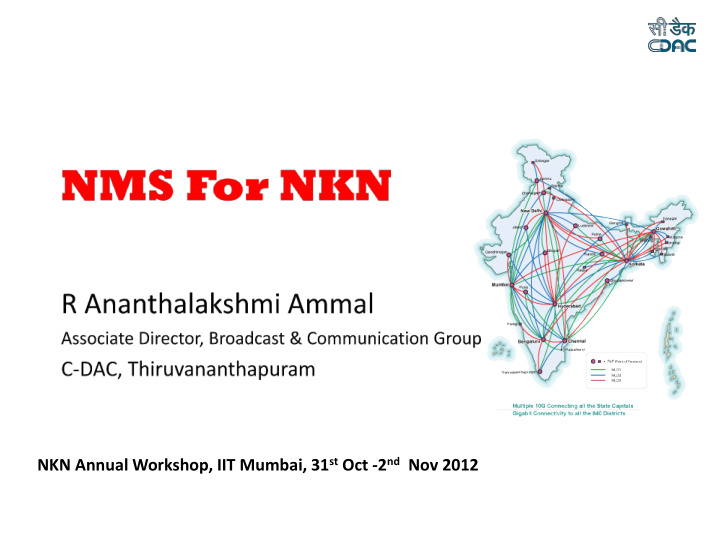



NKN Annual Workshop, IIT Mumbai, 31 st Oct -2 nd Nov 2012
Evolution of Network Management Systems Device centric approach 90’s Network Management meant device control and monitoring Mostly based on Simple Network Management Protocol (SNMP) Service and User centric approach 2000’s Has evolved into Operation Support System /Business Support System (OSS/BSS) Device centric approach is now the underlying layer
Network Management Related Standards TM ITU-T ITIL DMTF Forum IETF ETSI OMG • A single standard not enough to cover the management activities of heterogeneous networks • Combination of standards to be implemented as part of management systems
NKN Services • Videoconference Communication • Web Conference • VOIP and collaboration • Email • SMS gateways • MCU Services Digital content • Video Streaming • Video portals delivery • Virtual Classroom / library • Sharing of databases & Resources • Internet • DNS Internet Services • Web Hosting • Collocation • Shared Storage Academic • Virtual Classroom • Connectivity to international grid Network Support • L2 & L3 VLAN support
OSS for NKN Resource Management & Operation Service Management & Operation Resource Inventory Management Service Inventory Management Resource Location Management Service Request Management Resource Performance Management Resource Fault Management Service Performance Management Resource Usage Management Service Problem Management Resource Domain Management Service Quality Management Resource Security Management NKN OSS NKN Users Management SLA Management User Information Management User Access Management Service Provider SLA User Problem Management
Service Management & Operation Service Inventory Management • Retrieval, Update, Notifications, Service supporting resource inventory Service Request Management • Publication, Configuration, Activation Service Performance Management • Collect, Calculate, Archive ( Long term & Short Term), Identify problems, Trend Analysis, Dashboard Service Problem Management • Receive Events, Analyze, Resolve, Track, Report Service Quality Management • Collect, Analyze, Report
Resource Management & Operation Resource Inventory Management • Identify assets, Track Changes, Update, Generate notifications, Reports Resource Location Management • Geographical info, Building info, Floor info , Support topology maps, Search, Reports Resource Performance Management • Monitor, Analyse, Report Resource Fault Management • Monitor, Correlation & Root Cause Analysis, Correction, Report
Resource Management & Operation Resource Configuration Management • Configure, Backup, Restore, Track, Manage versions Resource Usage Management • Collect Usage Events, Process, Manage errors, Report Resource Domain Management • Discovery, Management & Access Domains Resource Security Management • Monitor, Analyse, Detect, Notify, Configure, Report
OSS – Architectural Considerations Distributed Hierarchical OSS ARCHITECTURE Measureme nt Granularity
Protocol Support for Data Collection
Major Challenges
Trends in Network Management Questions Can the systems manage themselves? which are trendsetters Can the systems adapt to changes of environment? Can the systems accept higher level directives from administrators and minimise human intervention? Can we change to Software Defined Networks and Open Flow Protocol? Can Network management be provided as Saas?
Autonomic Network Management Analyze Plan Knowledge Monitor Execute Managed Element
Policy Based Model Policies Policy Management Engine Monitor Configure Network
Policy Based Management for NKN Formulate policies for various aspects including • Security Policies • Network access policy • Scope of control • Scalability • Traffic management policies • Traffic classification(audio, video, web etc) • Degrees of control (rate, bandwidth, congestion level etc.) • User/Application Identification • Alert notifications • Time and day restrictions • User restrictions ( allow, deny, restricted URLs) Decide on the actions to be taken when an event or series of events happen Helps to automate the management process
Energy Aware Network Management The basic objective of is to operate communication networks and other equipment with a minimal amount of energy Provide means for reducing the power consumption of individual components of a network as well as of the whole network Instrumental in saving significant energy, if applied efficiently Implement policies to achieve energy efficiency
Management Functions for Energy Management Monitoring power states of network elements and their subcomponents Setting power states of network elements and their subcomponents Setting and enforcing power saving policies Autonomic principles can be applied for energy management by utilizing the monitor, analyze, decide and execute lifecycle for the activities .
Conclusion Policy Based Energy Aware RM&O SM&O SLA & User Mgmt OSS For NKN
Recommend
More recommend